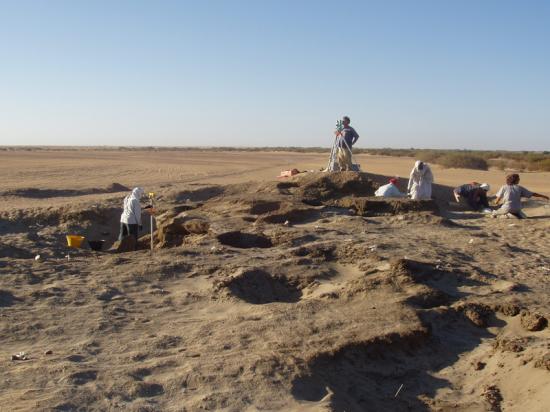Source - http://www.pasthorizonspr.com/index.php/archives/11/2014/domestic-cereals-in-evidence-7000-years-ago-in-sudan?

Plant particles found during the excavation of this Neolithic cemetery in Nubia (Sudan) turned out to be traces of domestic cereals when analyzed in a lab. Copyright: D. Usai/ S. Salvatori
Humans in Africa already exploited domestic cereals 7,000 years ago and thus several centuries earlier than previously known. Researchers have successfully verified ancient barley and wheat residues in grave goods and on teeth from two Neolithic cemeteries in North and Central Sudan.
The results of the analyses were recently published (online) in the journal PLoS ONE.
Dr. Welmoed Out from the University of Kiel was involved in the investigation. “With our results we can verify that people along the Nile did not only exploit gathered wild plants and animals but even crops of barley and wheat.”
These were first cultivated in the Middle East about 10,500 years ago and spread out from there to Central and South Asia as well as to Europe and North Africa – the latter faster than expected. “The diversity of the diet was much greater than previously assumed,” states Out and adds: “Moreover, the fact that grains were placed in the graves of the deceased implies that they had a special, symbolic meaning.”

One of the graves at the Neolithic cemetery in Nubia (Sudan), containing a skeleton and plant material deposited behind the skull (white structure at the left picture margin). Copyright: D. Usai/ S. Salvatori
The research team, coordinated by Welmoed Out and the environmental archaeologist Marco Madella from Barcelona, used a special high-quality light microscope as well as radiocarbon analyses for age determination. Mineral plant particles, so-called phytoliths, survive for a very long time, even when other plant remains are no longer discernible. In addition, calculus on the teeth provide evidence about the diet of these prehistoric humans due to the starch granules and phytoliths.
Read full paper here: http://www.plosone.org/article/info%3Adoi%2F10.1371%2Fjournal.pone.0110177
Abstract
The study of plant exploitation and early use of cereals in Africa has seen over the years a great input from charred and desiccated macrobotanical remains. This paper presents the results of one of the few examples in Africa of microbotanical analyses. Three grave contexts of phytolith-rich deposits and the dental calculus of 20 individuals were analysed from two Neolithic cemeteries in North and Central Sudan. The radiocarbon-dated phytoliths from the burial samples show the presence of Near East domestic cereals in Northern Sudan at least 7000 years ago. Phytoliths also indicate the exploitation of wild, savannah-adapted millets in Central Sudan between 7500 and 6500 years ago. The calculus samples contained starch grains from wheat/barley, pulses and millets, as well as panicoid phytoliths. This evidence shows that Near East domestic cereals were consumed in Northern Africa at least 500 years earlier than previously thought.